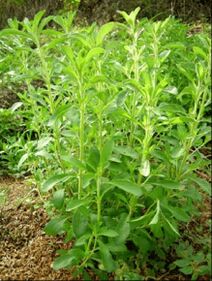Stevia rebaudiana
| Stevia rebaudiana | |
 | |
| Light: | |
| Moisture: | |
| Hardiness: | 9 |
| Soil pH: | 5.6-8.4 |
| Height: | 2' |
| Native to: | |
| Edible Rating: | |
| Tea: | Yes |
Stevia rebaudiana (common name: stevia) is a small herb with edible leaves that can be eaten raw or cooked. The leaves contain stevioside, a sweetening agent that is 300 times sweeter than sucrose,[1] as well as estevin, which is 150 times sweeter than sucrose.[2][3][4][5] Both stevioside and estevin do not contain calories and has a negligible impact insulin levels.[6] A tincture is made from the leaves and used as a sugar substitute.
Propagation: Seed - sow spring in a warm greenhouse and only just cover the seed. Make sure the compost does not dry out. Prick out the seedlings into individual pots and grow them on fast, planting them out after the last expected frosts. It could be worthwhile giving them some protection such as a cloche or cold frame for a few weeks after planting them out until they are growing away well.
Cultivation: Prefers a sandy soil, requiring a warm sunny position[7].
Plants are not very frost resistant, but can be grown as half-hardy annuals in Britain, starting them off in a greenhouse and planting them out after the last expected frosts.
Range: S. America - Brazil, Paraguay.
Edibility: Leaves - raw or cooked. A very sweet liquorice-like flavour[K]. The dried leaves can be ground and used as a sweetener or soaked in water and the liquid used in making preserves[1]. The powdered leaves are also added to herb teas[1]. The leaves are sometimes chewed by those wishing to reduce their sugar intake[1]. The leaves can also be cooked and eaten as a vegetable[5][8].
Pollinators: Insects
Notes: We would need to obtain the seed and could supply in the year after it germinated.
Soil: Can grow in light and medium soils.
Flower Type: Hermaphrodite
Also Known As: Eupatorium rebaudianum.
Links
References
- ↑ 1.0 1.1 1.2 1.3 Facciola, Stephen. Cornucopia - A Source Book of Edible Plants. Kampong Publications, 1990.
- ↑ Grieve, Margaret. A Modern Herbal. Penguin, 1984.
- ↑ Uphof, Johannes. Dictionary of Economic Plants. Weinheim, 1959.
- ↑ Usher, George. A Dictionary of Plants Used by Man. Constable, 1974.
- ↑ 5.0 5.1 Tanaka, Tyōzaburō. Tanaka's Cyclopaedia of Edible Plants of the World. Keigaku Publishing, 1976.
- ↑ https://www.youtube.com/watch?v=CYfqvTZWilw&t=204s
- ↑ Huxley, Anthony. The New Royal Horticultural Society Dictionary of Gardening. MacMillan Press, 1992.
- ↑ Kunkel, Günther. Plants for Human Consumption. Koeltz Scientific Books, 1984.